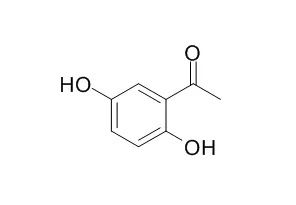| Description: |
2,5-Dihydroxyacetophenone is an uncompetitive inhibitor of murine tyrosinase (K(I) 0.28mm), it strongly inhibits both melanogenesis and cellular tyrosinase activity, it possesses anti-inflammatoryanti-anxiety, and neuroprotective qualities. 2,5-Dihydroxyacetophenone treatment can induce a sustained activation of JNK, ERK1/2, and p38 MAPKs, it also can potentiate the pro-apoptotic and anti-proliferative effects of bortezomib in U266 cells. |
| Targets: |
JNK | ERK | p38MAPK | p21 | Bcl-2/Bax | COX | MMP(e.g.TIMP) | NF-kB | Tyrosinase |
| In vitro: |
| J Med Food. 2012 Jun;15(6):505-10. | | 2,5-dihydroxyacetophenone isolated from Rehmanniae Radix Preparata inhibits inflammatory responses in lipopolysaccharide-stimulated RAW264.7 macrophages.[Pubmed: 22510152 ] | Rehmanniae Radix Preparata, the steamed root of Rehmannia glutinosa Libosch, has been widely used for the treatment of inflammatory conditions in Oriental medicines.
METHODS AND RESULTS:
In this study we evaluated the effects of 2,5-Dihydroxyacetophenone (DHAP) isolated from Rehmanniae Radix Preparata on inflammatory responses in lipopolysaccharide (LPS)-stimulated RAW264.7 mouse macrophages. LPS-stimulated RAW264.7 cells were used to investigate the anti-inflammatory activity of DHAP on the production of inflammatory mediators such as nitric oxide (NO), inducible NO synthase (iNOS), tumor necrosis factor-α (TNF-α), and interleukin (IL)-6. DHAP significantly inhibited NO production via the suppression of iNOS expression and significantly decreased levels of the pro-inflammatory cytokines TNF-α and IL-6 via the down-regulation of their mRNA expression in LPS-stimulated RAW264.7 cells. DHAP potently inhibited the phosphorylation of extracellular signal-related kinase (ERK) 1/2 and the nuclear translocation of nuclear factor-κB (NF-κB) p65 in LPS-stimulated cells. These results indicate that DHAP inhibits the production of inflammatory mediators in activated macrophages by blocking the ERK1/2 and NF-κB signaling pathways.
CONCLUSIONS:
Our results suggest that DHAP from Rehmanniae Radix Preparata has anti-inflammatory activity in activated macrophages, raising the possibility that this compound has a therapeutic potential for inflammatory conditions. |
|
| In vivo: |
| Exp Dermatol. 2011 Sep;20(9):720-4. | | Murine tyrosinase inhibitors from Cynanchum bungei and evaluation of in vitro and in vivo depigmenting activity.[Pubmed: 21615508] |
METHODS AND RESULTS:
Two natural acetophenone derivatives, 2,5-Dihydroxyacetophenone (2,5-DHAP) and 2,6-DHAP, were purified from Cynanchum bungei and identified as murine tyrosinase inhibitors. Investigation into 2,5-DHAP showed it to be an uncompetitive inhibitor of murine tyrosinase (K(I) 0.28 mm). 2,5-DHAP strongly inhibited both melanogenesis and cellular tyrosinase activity in vitro in 3-isobutyl-1-methylxanthin-stimulated B16 mouse melanoma cells or in vivo in zebrafish and mouse models, but showed no cytotoxicity at the concentrations used. In B16 cells, 2,5-DHAP inhibition was dose-dependent and was fourfold greater than that of arbutin. 2,5-DHAP had no effect on the expression of tyrosinase protein or mRNA, as confirmed by Western blotting and quantitative real-time reverse transcription polymerase chain reaction, respectively.
CONCLUSIONS:
A 2% gel preparation of 2,5-DHAP applied to the skin of mice significantly increased the average skin-whitening index (L value), indicating its potential use as a treatment for skin hyperpigmentation in humans. |
|






 Cell. 2018 Jan 11;172(1-2):249-261.e12. doi: 10.1016/j.cell.2017.12.019.IF=36.216(2019)
Cell. 2018 Jan 11;172(1-2):249-261.e12. doi: 10.1016/j.cell.2017.12.019.IF=36.216(2019) Cell Metab. 2020 Mar 3;31(3):534-548.e5. doi: 10.1016/j.cmet.2020.01.002.IF=22.415(2019)
Cell Metab. 2020 Mar 3;31(3):534-548.e5. doi: 10.1016/j.cmet.2020.01.002.IF=22.415(2019) Mol Cell. 2017 Nov 16;68(4):673-685.e6. doi: 10.1016/j.molcel.2017.10.022.IF=14.548(2019)
Mol Cell. 2017 Nov 16;68(4):673-685.e6. doi: 10.1016/j.molcel.2017.10.022.IF=14.548(2019)